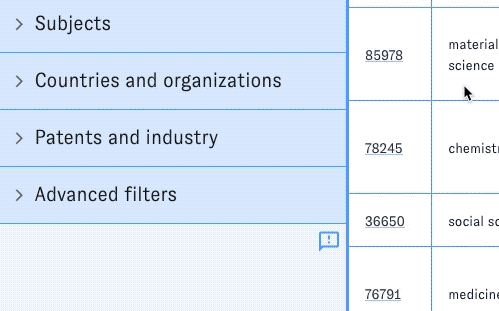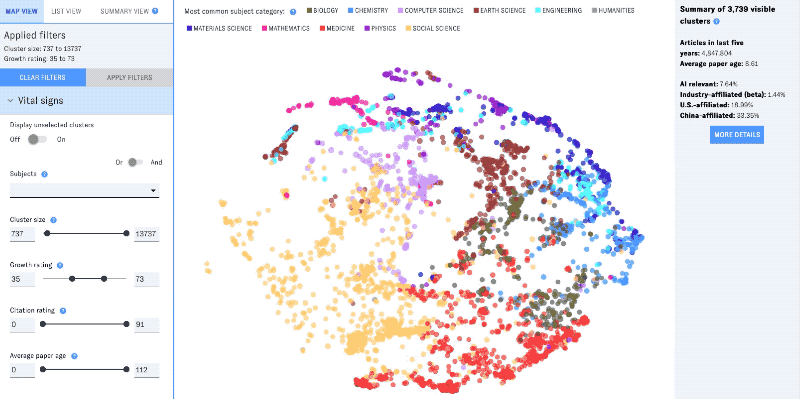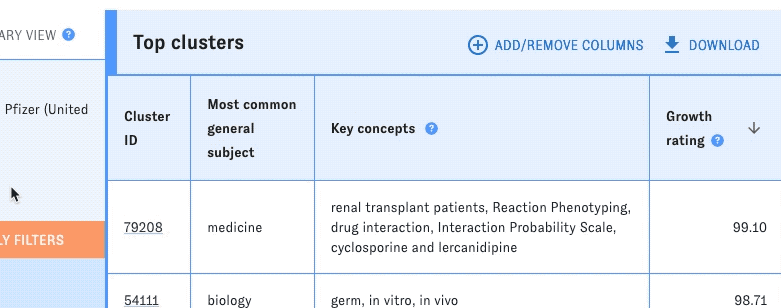Over the past year, thousands of users have relied on ETO's Map of Science for insight into global research and technology trends. Meanwhile, we've engaged with users across government, nonprofits, academia and the private sector to understand how the Map should grow and change to better meet your needs. Today, we're excited to announce powerful new features and data improvements to the Map. Developed in partnership with CSET's data team, these latest upgrades are live and ready for use at https://sciencemap.eto.tech. Stay tuned for more exciting Map of Science updates in 2024!
Map different countries' research activity with our enhanced search
We've reengineered the Map's country search to bring in more relevant results for a wider range of countries. Apply the "Leading country" filter to identify all of the Map's research clusters with a high rate of authorship (top-3 across all countries) from the country you designate.
- What are some rapidly growing areas of research where Indonesian researchers play a leading role? What about Argentina, Germany, or Nigeria?
- What are the highest-cited research areas where South Korean scientists are especially active? What about Canadian scientists?

Track key organizations across the research landscape
Longtime users know that the Map's detail view tracks the top authoring and funding organizations in each specific cluster. Now, you can search the entire map by these organizations, helping you quickly build profiles of different organizations' research "portfolios," pinpoint research areas where your school or company (or another one) is active, and more. (Data about funding organizations is sometimes incomplete in the Map's underlying sources, so results from the Map's funder search should be interpreted as examples of that organization's activity, not as exhaustive.)
- Show me areas of research activity for Georgetown University, the University of Florida, Tsinghua University, Pfizer, IBM, or Oak Ridge National Laboratory.
- What are some examples of research areas funded by the National Institutes of Health? How about Fujian Province in China, or the Gordon and Betty Moore Foundation?
Use summary view to profile entire domains of research
The Map's recently launched summary view generates high-level profiles for any type of research that you can describe using the Map's filters - making it a great way to draw broad insights about the research that interests you most. For more on summary view and how to use it, check out our earlier blog post.

Uncover trends in AI safety research
ETO's model for identifying research related to AI safety is now integrated into the Map of Science as a new search filter. Use the slider to identify clusters with a high proportion of AI safety research - or mix and match with other filters for more complex views.
Export your analysis from the Map's list view
Bring your results to your own analytic environment with the new export feature in the Map's list view. After building a query using the Map's search filters and customizing your results in list view, just click to download the cluster metadata in csv format.

Updated data from a new lineup of leading sources
The Map's new features and user-friendly interface are backed by ETO's unmatched bibliometric data holdings, including the multi-source Merged Academic Corpus and the Research Cluster Dataset. Both datasets have been updated with the latest information from OpenAlex, Semantic Scholar, The Lens, Clarivate Web of Science, arXiv, and Papers With Code, providing broad coverage of the global research landscape.
At the same time, we're unfortunately no longer able to integrate data from China's CNKI. Although the Map still covers over 16 million Chinese-affiliated publications (and counting), this means that many Chinese-language publications that were covered in earlier iterations of the Map are no longer included. Users should exercise caution when interpreting data from the Map related to Chinese research organizations, funders, or authors.
To learn more about our sources, how we assemble and merge data from them, and the structure and known limitations of the resulting ETO datasets, visit our recently revised user guides, or feel free to contact the ETO team for one-on-one support. 🤖

